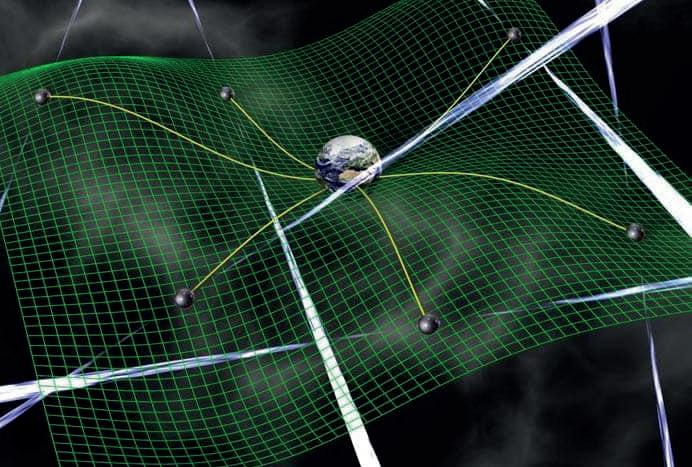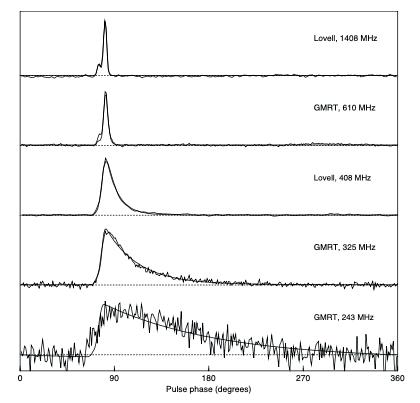
10 minute read
Let’s talk about... pulsars
from Contact 15
BY CASSANDRA CAVALLARO (SKAO)
In January, astronomers announced they had found a mysterious object lighter than the lightest known black hole, but heavier than the heaviest known neutron star, therefore known as a “mass-gap object” (see page 25). It was detected thanks to its effect on its orbital companion: a millisecond pulsar.
Pulsars are the corpses of huge stars that have gone out in a blaze of glory. When a massive star gets to the end of its life and explodes in a supernova, its core undergoes a gravitational collapse. If its mass after the supernova is greater than three times the mass of our Sun, then a black hole is formed, but if it’s less than that then gravity continues to compact the matter until a neutron star is formed, so-called because the force of the gravitational collapse crushes protons and electrons together, leaving neutrons.
A neutron star is almost unimaginably dense. It has a mass similar to the Sun, but measures only around 20 km across. Our friends at NASA have calculated that a single sugar cube made of neutron star material would weigh around a billion tonnes on Earth – that’s more than 99,000 Eiffel Towers!
Many neutron stars spin rapidly, sending out a stream of radio waves as they do so which can be observed by radio telescopes on Earth. As we can only see the radio waves when the stream points towards Earth, it appears like a pulse, hence the name “pulsars”.
“Pulsars have really strong magnetic fields, and because they’re spinning rapidly, the magnetic fields act as a dynamo, accelerating particles towards the pulsar’s magnetic poles at close to the speed of light,” explains Dr Hao (Harry) Qiu, astronomer and SKAO radio spectrum scientist.
The pulses are often compared to the beam of a lighthouse, so regular and reliable that any variation in the arrival time of that pulse as observed from Earth can be used to infer the effect of another object – as in the case of the mass-gap object mentioned earlier – or cosmic incident.
We’ll get more into the physics of their behaviour shortly, but first, some history.
Discovered in 1967 by Prof. Dame Jocelyn Bell Burnell, then a graduate student, pulsars have been at the centre of some of the biggest discoveries in astrophysics. In 1992, the first confirmed exoplanets were detected by observing their effects on the pulsar they were orbiting.
Twenty years earlier, the first indirect evidence that gravitational waves exist came from observations of a pulsar in a binary system, a discovery that would later win the Nobel Prize.
Speaking of that most coveted of awards, Dame Jocelyn’s contribution was infamously overlooked when the Nobel Committee bestowed the 1974 prize for physics on her supervisor, Prof. Antony Hewish, “for his decisive role in the discovery of pulsars”. Prof. Hewish shared the prize that year with Prof. Martin Ryle. Dame Jocelyn is now a highly decorated and world-renowned astrophysicist.
To date, more than 3,300 pulsars have been found, almost all of them within the Milky Way – only 1% have been found beyond our galaxy, in the Magellanic Clouds.
Back to pulsar behaviour. Perhaps the most obvious question is: why do they spin?
“When a pulsar is created from a supernova, it often retains the spinning momentum of the giant star that exploded. As it is roughly five to 10 times smaller in mass, the newborn pulsar will be spinning at a very fast rate,” Harry says.
This is known as conservation of angular momentum: the star was rotating, and therefore its remnant also rotates, only faster because its mass is now compacted more tightly.
Spinning, fast and slow
Pulsars don’t all spin at the same speed, in fact they vary quite greatly. The fastest are known as millisecond pulsars, and the quickest of those that we know of rotates a dizzying 716 times per second. Known as PSR J1748-2446ad (pulsars are named using their astronomical coordinates), it was discovered by Prof. Jason Hessels, co-chair of the SKAO’s Transients Science Working Group.
In pulsar science, as in life, timing is everything. Millisecond pulsars can be used to form pulsar timing arrays, which are effectively galactic observatories. By finding millisecond pulsars in our galaxy, and timing the arrival of their pulses with exceptional precision, radio telescopes can detect any tiny shifts in those timings which are caused when gravitational waves distort time as they pass through the galaxy (read more about that in Contact issue 5).
Pulsar timing arrays are designed to detect the low-frequency gravitational wave background, the background waves thought to be caused by the slow merging of supermassive black holes (rather than the higher frequency waves caused by the violent collisions of less massive bodies, which are detected by other bespoke instruments either in space or here on Earth). A major breakthrough in 2023 saw multiple pulsar timing array projects worldwide unite to find the first evidence for these low-frequency waves.
At the other end of the activity spectrum to millisecond pulsars, the slowest known pulsar was detected in 2022, taking a leisurely 76 seconds to rotate. This begs the question: why do they have such different spin speeds? It depends on what phase of its existence the pulsar is in, and on its environment.
“As a pulsar rotates, the kinetic energy for it to spin is converted to the radio waves emitted, causing it to gradually lose energy and slow down, which we call ‘spin down rate’,” Harry says. “This isn’t necessarily a one-way street though; some pulsars may be powered up again by a companion star that feeds matter into the pulsar to make it spin faster! It’s thought that many millisecond pulsars are actually very old, having been sped up in this way.”
For those without such invigorating companions, the loss of spin is basically a death spiral. If a pulsar slows down too much, radio waves are no longer emitted, and the lighthouse beam goes out – this is known as the death line. When a pulsar’s spin rate falls below the death line, it is generally no longer detectable by radio telescopes. There are a few rare cases of pulsars emitting radio waves despite spinning at a very slow rate, below the death line, including the one with a 76-second rotation mentioned earlier. It’s thought a different emission mechanism could be at play here.
Pulsars’ spin-down rate is measured over millions of years. Over shorter time frames they are generally considered highly stable, often being compared to the most accurate atomic clocks on Earth. They do, however, sometimes exhibit erratic behaviour.
Even some of the most stable pulsars are known to “glitch”, where the rotation speed suddenly quickens, then gradually returns to normal over months or years. Glitches are thought to be caused by physical processes taking place within the pulsar. There are other behaviours which also point to pulsars being, as Harry puts it, “quite funky”.
“Some pulsars are also known to have two or more different modes of emission, for example emitting bright sporadic wide pulses and then turning off into a fainter weaker mode, all while maintaining the same rotation period. Others exhibit ‘nulling’, where they cease their emission altogether. We don’t fully understand why these things happen yet.”
“There are also some very unusual pulsars called magnetars which seem to be powered directly by their extremely strong magnetic fields – which are around 1,000 times stronger than regular pulsars – instead of being rotation powered!” Harry says. “We need to study them more to understand the underlying emission mechanisms.”

Probes of interstellar space
As well as pulsars being interesting in their own right, their radio signals are also useful vessels of information gathered on their journey towards Earth.
A pulsar’s radio signal covers a range of frequencies (unlike neutral hydrogen, for example, which emits at one specific frequency), and light/radio waves at different frequencies are affected differently by the environment.
“As the signal travels through the interstellar medium, it’s like going through glass – the radio waves get slowed down by different amounts at different frequencies. We describe the amount of delay as a dispersion measure, and it tells us how thick the interstellar medium the pulse has travelled through is,” Harry says. “If the interstellar medium is also very turbulent, or ‘clumpy’, the radio waves from the pulsar are scattered through different paths and are delayed at different rates, where at lower frequencies the delay difference is much greater, so astronomers see a pulse that looks different, with a broadened ‘tail’.

“You can think of a pulsar’s radio waves as being like a beam of light. They allow us to probe the interstellar medium of our galaxy just like using a laser beam to study the properties of a material,” Harry says. “We can use the signals to measure magnetic environments, because as they travel through magnetic fields a process called Faraday rotation takes place which ‘twists’ the radio waves. Measuring that rotation means we can measure the strength of the magnetic field.”
Pulsars in the SKAO era
For radio studies of pulsars, the equation is quite simple: higher telescope sensitivity = better timing precision. The SKA telescopes will have much higher sensitivity than existing instruments, because the telescopes’ collecting area will be much greater owing to the sheer number of antennas. This means they will be able to time a pulse’s arrival to better than 100-nanoseconds accuracy – that’s 10 millionths of a second!
“That level of accuracy for pulsar timing is really unprecedented. Pulsar timing arrays are already in use of course, including the major MeerTIME project using the MeerKAT radio telescope, so we will be able to build on that and take things up a notch. By detecting the very faint signature of gravitational waves affecting radio signals coming from pulsars, we will be able to prove beyond doubt the existence of the elusive low-frequency gravitational wave background, and confirm its origin,” says Harry.
Astronomers also want to use the telescopes’ pulsar capabilities to test Einstein’s theories of gravity in the most extreme environment: around a black hole, where the strength of gravity causes space-time to become highly warped. Einstein made predictions about the nature of black holes and how such extreme gravity would delay light travelling through space.
Harry said: “If we can find a pulsar orbiting a black hole, we can use the SKA telescopes to time the pulses’ arrival with exceptional precision to see if our observations match what Einstein predicted. If they do, then Einstein was correct, but if not then that means that our current understanding of gravity doesn’t apply to these extreme environments. We’d be moving into the unknown, and that’s a really exciting prospect!”
With thanks to Dr Maciej Serylak, SKAO Deputy System Scientist, Architecture, for additional contributions.










